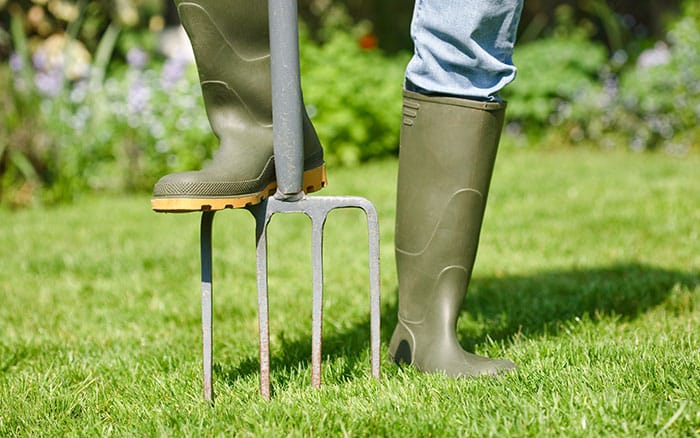Autumn is traditionally a time when things start to wind down for the year in the garden. Garden tools are being cleaned and put away for the year. And fallen leaves are collected, and even a late lawn cut or two may be made.
Before you completely shut the garden gate for the year, there’s one more job that’s ideal to do now. And that’s aerating the lawn.
What is lawn aeration?
Lawn aeration is the process of getting air into the soil under the lawn. The clue is quite literally in the name. It’s a simple way of helping keep your lawn, along with the soil and microorganisms, in tip-top condition.

Your lawn has to deal with many different things over a calendar year. Such as people regularly walking and sitting on it, as well as children playing ball games. And, as a result, the soil underneath can become compacted, especially if it’s clay-based.
Plus, compacted soil means grass roots can’t grow deep into the soil, which means the lawn will suffer the effects of drought.
Much more than one where the soil under it is well drained and aerated. Badly drained soil can create ideal conditions for moss to grow, plus stopping grass growing well.
Getting air into the soil will therefore help grass thrive, as well as break up compacted soil.
When should the lawn be aerated?
The best time to aerate the lawn is when conditions are mild and the grass is growing well. It can be done in spring, but the weather can be unpredictably bad at that time of the year, and gardeners are busy sowing seeds and other garden jobs. Therefore Autumn, with its mild, moist conditions, is usually the ideal time to do it.
How to aerate the lawn
The most basic way to aerate a lawn is to spike it all over with a garden fork, going down as deep as possible. Ideally to the full length of its tines. Then, move the fork back and forth in the soil to enlarge the holes.
This method may not be feasible if you have a large area of lawn, and it can also be quite hard work! However, if that’s the case, it might be worthwhile buying or hiring a powered or mechanical aerator to do the job for you.


For a bit of fun, you can buy shoes with spikes on the bottom which aerate the soil as you walk across it wearing them. The downside is that the holes aren’t very deep.
If your soil is clay-based, a hollow-tined aerator is more effective. This not only makes wider holes, maximising the amount of air and water circulating the grass’s roots. But also, the hollow tines take out plugs of soil which can be replaced by sweeping a top-dressing of sand and well-rotted compost into the holes. This will help improve soil structure and drainage.
By aerating your lawn, you will massively improve its general health, and put it in a better position to start growing again next spring.

Leave A Comment